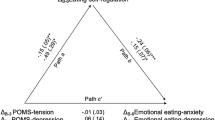Abstract
Forty-eight female volunteers, between the ages of 20 and 55 years and at least 25% overweight, participated in a weight reduction program. The program factorially varied 24 hr of restricted environmental stimulation (lying on a bed in a dark, silent room) and a set of self-management messages. The combined treatment was significantly more effective than the other three conditions during a 6 month follow-up period; the mean weight loss during the first 2 months was primarily a function of the messages, while the reduced stimulation environment effect became dominant during the last 4 months of followup.
Similar content being viewed by others
References
Adams, H. B., Robertson, M. H., and Cooper, G. D. (1966). Sensory deprivation and personality change.J. Nerv. Mem. Dis. 143: 256–265.
Azima, H., and Cramer-Azima, F. J. (1956). Effects of partial perceptual isolation in mentally disturbed individuals.Dis. Nerv. System 17: 117–122.
Barber, T. X. (1965). Measuring “hypnotic-like” suggestibility with and without “hypnotic induction.” Psychometric properties, norms and variables influencing response to the Barber Suggestibility Scale.Psychol. Rep. 10: 809–844.
Barnes, L. J. (1976).Comparative Effectiveness of a Five Day Plan and a Sensory Deprivation Program on Reduction and Abstinence from Cigarette Smoking, unpublished Master's thesis, Dalhousie University.
Best, J. A., and Suedfeld, P. (1980). Restricted environmental stimulation therapy and behavioral self-management in smoking cessation (in preparation).
Cleveland, S. E., Reitman, E. E., and Bentinck, C. (1963). Therapeutic effectiveness of sensory deprivation.Arch. Gen. Psychiat. 8: 455–460.
Cooper, G. D., Adams, H. B., and Cohen, L. D. (1965). Changes in personality after sensory deprivation.J Nerv. Ment. Dis. 140: 103–118.
Gibby, R. G., and Adams, H. B. (1961). Receptiveness of psychiatric patients to verbal communication: An increase following partial sensory and social isolation.Arch. Gen. Psychiat. 5: 366–379.
Kammerman, M. (1977). Personality changes resulting from water-suspension sensory isolation. In Kammerman, M. (ed.),Sensory Isolation and Personality Change, Charles C Thomas, Springfield, Ill.
Maier, W. J. (1970). Sensory deprivation therapy of an autistic boy.Am. J. Psychother. 25: 228–245.
Mandler, G., Mandler, J. M., and Uvillar, E. T. (1958). Autonomic feedback: The perception of autonomic activity.J. Abnorm. Soc. Psychol. 56: 367–373.
Martin, D. G., Rousch, P., and Nicholson, J. V. (1967). Increased effect of a visual training procedure after sensory restriction.Psychonom. Sci. 8: 229–230.
Metropolitan Life Insurance Company. (1959). New weight standards for men and women.Stat. Bull. 40: 1–4.
Patrick, R. O. (1965). Partial sensory depatterning and propaganda assimilation.Dissert. Abstr. Int. 26: 3488–3489.
Peevers, B. H., Blascovich, J. I., and Secord, P. F. (1974). The Personal Causality Questionnaire.JSAS Cat. Selected Documents Psychol. 4: 15.
Reid, D. W., and Ware, E. E. (1974). Multidimensionality of internal versus external control: Addition of a third dimension and non distinction of self versus others.Can. J. Behav. Sci. 6: 131–142.
Reitman, E. E., and Cleveland, S. E. (1964). Change in body image following sensory deprivation in schizophrenic and control groups.J. Abnorm. Soc. Psychol. 68: 168–176.
Robertson, M. (1965). Therapeutic effectiveness of verbal communication under conditions of perceptual isolation.Am. Psychol. 20: 548 (abstr.).
Schechter, M. D., Shurley, J. T., Sexauer, J. D., and Toussieng, P. W. (1969). Perceptual isolation therapy: A new approach in the treatment of children using autistic defenses. A preliminary report.J. Am. Acad. Child Psychiat. 8: 97–139.
Snyder, M. (1974). Self-monitoring of expressive behavior.J. Personal. Soc. Psychol. 30: 526–537.
Stuart, R. B. (1967). Behavioral control of overeating.Behav. Res. Ther. 5: 357–365.
Stuart, R. B. (1971). A three-dimensional program for the treatment of obesity.Behav. Res. Ther. 9: 177–186.
Stuart, R. B., and Davis, B. (1972).Slim Chance in a Fat World: Behavioral Control of Obesity, Research Press, Champaign, Ill.
Stunkard, A. J. (1975). From explanation to action in psychosomatic medicine: The case of obesity.Psychosom. Med. 37: 195–236.
Stunkard, A. J., and McLaren-Hume, M. (1959). The results of treatment for obesity.Arch. Intern. Med. 103: 79–85.
Suedfeld, P. (1975). The clinical relevance of reduced sensory stimulation.Can. Psychol. Rev. 16: 88–103.
Suedfeld, P. (1977). Using environmental restriction to initiate long-term behavioral change. In Stuart, R. B. (ed.),Behavioral Self-Management: Strategies, Techniques and Outcomes, Brunner/Mazel, New York.
Suedfeld, P. (1980).Restricted Environmental Stimulation: Research and Clinical Applications, Wiley, New York.
Suedfeld, P., and Best, J. A. (1977). Satiation and sensory deprivation combined in smoking therapy: Some case studies and unexpected side-effects.Int. J. Addict. 12: 337–359.
Suedfeld, P., and Buchanan, E. (1974). Sensory deprivation and autocontrolled aversive stimulation in the reduction of snake avoidance.Can. J. Behav. Sci. 6: 105–111.
Suedfeld, P., and Hare, R. D. (1977). Sensory deprivation in the treatment of snake phobia: Behavioral, self-report and physiological effects.Behav. Ther. 8: 240–250.
Suedfeld, P., and Ikard, F. F. (1973). Attitude manipulation in restricted environments. IV. Psychologically addicted smokers treated in sensory deprivation.Br. J. Addict. 68: 170–176.
Suedfeld, P., and Ikard, F. F. (1974). The use of sensory deprivation in facilitating the reduction of cigarette smoking.J. Consult. Clin. Psychol. 42: 888–895.
Suedfeld, P., Landon, P. B., Pargament, R., and Epstein, Y. M. (1972). An experimental attack on smoking (Attitude manipulation in restricted environments, III).Int. J. Addict. 7: 721–731.
Suedfeld, P., and Smith, C. A. (1973). Positive incentive value of phobic stimuli after brief sensory deprivation: Preliminary report.Percept Motor Skills 36: 320.
Witkin, H. A., Lewis, H. B., Hertzman, M., Machover, K., Meissner, P. B., and Wagner, S. (1954).Personality Through Perception, Harper, New York.
Author information
Authors and Affiliations
Additional information
This report is part of a doctoral dissertation by the first author under the supervision of the second author. We would like to thank Carmenza Ramirez for taking the skinfold measurements and Dr. Richard B. Stuart for extensive consultation and advice.
Rights and permissions
About this article
Cite this article
Borrie, R.A., Suedfeld, P. Restricted environmental stimulation therapy in a weight reduction program. J Behav Med 3, 147–161 (1980). https://doi.org/10.1007/BF00844987
Accepted:
Issue Date:
DOI: https://doi.org/10.1007/BF00844987




